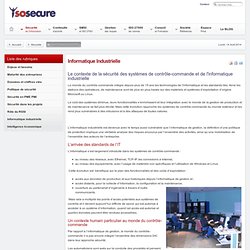

ICS, SCADA Myth: Protection by Firewalls. By Andrew Ginter Today we are talking about a fairy tale.
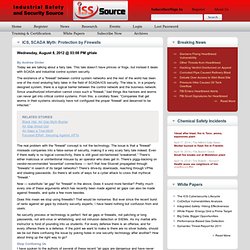
This tale doesn’t have princes or frogs, but instead it deals with SCADA and industrial control system security. The existence of a “firewall” between control system networks and the rest of the world has been one of the most enduring fairy tales in the field of SCADA/ICS security. The idea is, in a properly designed system, there is a logical barrier between the control network and the business network. Since unauthorized information cannot cross such a “firewall,” bad things like hackers and worms can never get into critical control systems. From this, a corollary flows: “Companies that get worms in their systems obviously have not configured the proper ‘firewall’ and deserved to be infected.” RELATED STORIESBlack Hat: Air Gap Myth BusterAir Gap Shout OutAir Gaps a True MythFocused Effort: Securing Against APTs The real problem with the “firewall” concept is not the technology.
Does this mean we stop using firewalls? Industrial IT - Energy Sector. Industrial Control Systems/SCADA. Critical infrastructures, such as electricity generation plants, transportation systems, oil refineries, chemical factories and manufacturing facilities are large, distributed complexes.
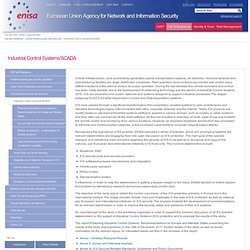
Plant operators must continuously monitor and control many different sections of the plant to ensure its proper operation. During the last decades this remote command and control has been made feasible due to the development of networking technology and the advent of Industrial Control Systems (ICS). Control Systems - Standards and References.
This page provides an extensive bibliography of references and standards associated with control system cyber topics.
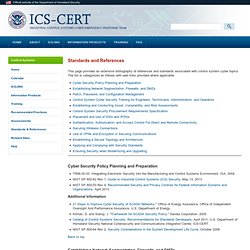
The list is categorized as follows with web links provided where applicable: Cyber Security Policy Planning and Preparation Additional Information 21 Steps to Improve Cyber Security of SCADA Networks," Office of Energy Assurance, Office of Independent Oversight And Performance Assurance, U.S. Department of Energy.Kilman, D. and Stamp, J. Back to top Establishing Network Segmentation, Firewalls, and DMZs Catalog of Control Systems Security: Recommendations for Standards Developers, April 2011, U.S.
Patch, Password, and Configuration Management Ashier, J. and Weiss, J. State of SCADA Security 'Laughable', Researchers Say. Mary E. Shacklett - Can Next Generation SCADA Security Thwart Cyber Attacks? National Laboratories: SCADA Engineering Solutions. Sandia’s SCADA Security Program leverages expertise developed over many years of experience in national security and securing high consequence systems.

Sandia is a recognized leader in critical infrastructure protection, cyber security, and energy system solutions. CobiT (TM) and Security Policy Utilizes “control objectives” to maintain “IT governance”Maintained by a non-profit organizationDesigned to be auditable.Intended to inclusive of other control structuresComparable models include:SysTrustISO/IEC 17799SSE-CMMOther Proprietary ModelsProvides framework to sustain system security.
Enseignements du « Scada Security Scientific Symposium » (S4) Le symposium S4, qui a eu lieu fin janvier à Miami, marque une nouvelle étape dans l’odyssée de Charybde à Scylla de la cybersécurité industrielle.
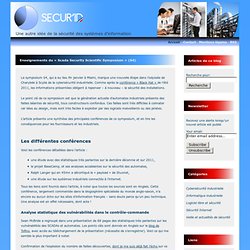
Comme après la conférence « Black Hat » de l’été 2011, les informations présentées obligent à repenser – à nouveau – la sécurité des installations. Le point clé de ce symposium est que la génération actuelle d’automates industriels présente des failles béantes de sécurité, tous constructeurs confondus. Ces failles sont très difficiles à colmater car liées au design, mais sont très faciles à exploiter par des logiciels malveillants ou des pirates. L’article présente une synthèse des principales conférences de ce symposium, et en tire les conséquences pour les fournisseurs et les industriels.
Internet Worm Targets SCADA. Abstract Page. Browse Results. SCADA : les responsables sécurité prennent leurs marques. Monaco, envoyé spécial - Le virus Stuxnet a remis sur le devant de la scène la sécurité des systèmes industriels, souvent critiques comme le sont ceux pilotant les centrales nucléaires, par exemple.
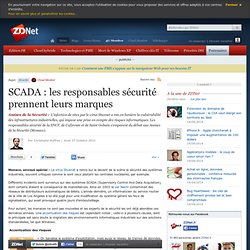
Différents incidents sont survenus sur des systèmes SCADA (Supervisory Control And Data Acquisition), dont certains étaient la conséquence de malveillances. Ainsi en 2003 le ver Nachi contaminait des réseaux de distributeurs automatiques de billets. L'année dernière, un informaticien du service routier de la ville de Los Angeles a lui été jugé pour une modification du système gérant les feux de signalisation, qui avait provoqué quatre jours d'embouteillage.
Pour autant, les menaces ne sont pas nouvelles et les experts de la sécurité les ont déjà abordées ces dernières années. Vital utilities vulnerable to hacking - tech - 02 December 2011. Cyberattacks could easily bring down infrastructure such as water facilities and power plants, as recent events have shown.

But help is at hand A HACKER virtually tiptoeing around a Texas water plant, and a burned-out pump at an Illinois water treatment facility: both incidents, which happened last month, made headline news because cybersecurity breaches seemed to be behind them, though no one was harmed. Initial reports said Russian hackers were behind the Illinois accident. While officials now say there is "no evidence" that this was the case the two events illustrate how worried people are that vital infrastructure is vulnerable to cybercrime. News of the suspected attacks came as a study revealed that poor cybersecurity measures in the Netherlands water industry could let attackers contaminate water supplies or cut them off entirely, holding whole nations to ransom.
A SCADA sends instructions to shopfloor machines like pumps, valves, robot arms and motors. But it won't be easy. Informatique Industrielle. Le contexte de la sécurité des systèmes de contrôle-commande et de l'informatique industrielle Le monde du contrôle-commande intègre depuis plus de 15 ans les technologies de l'informatique et les standards liés.
